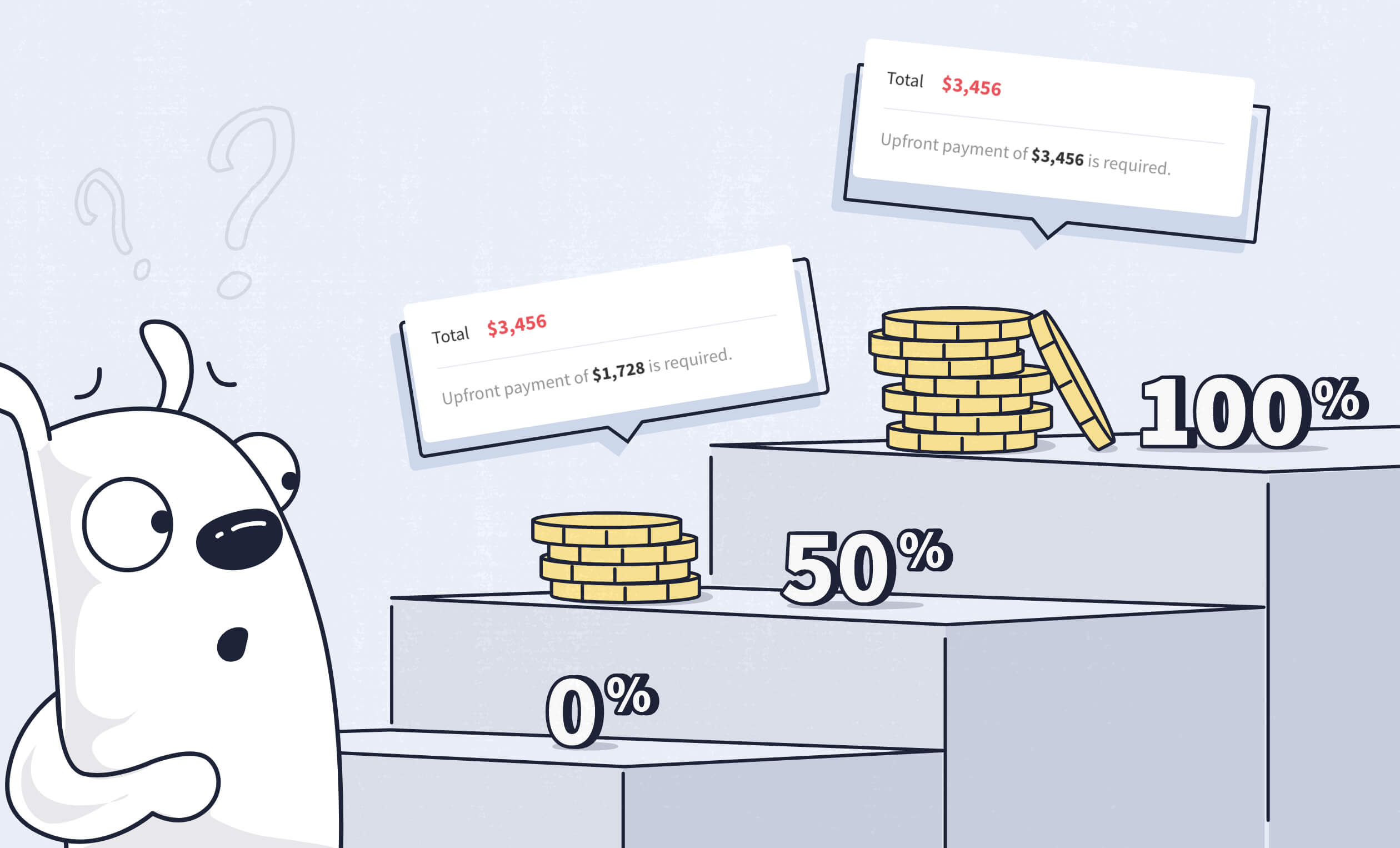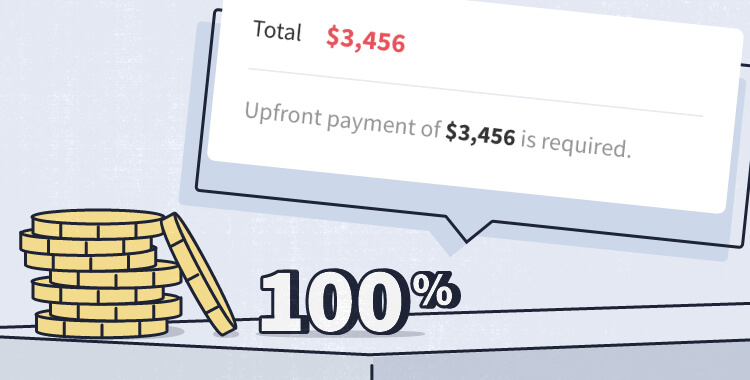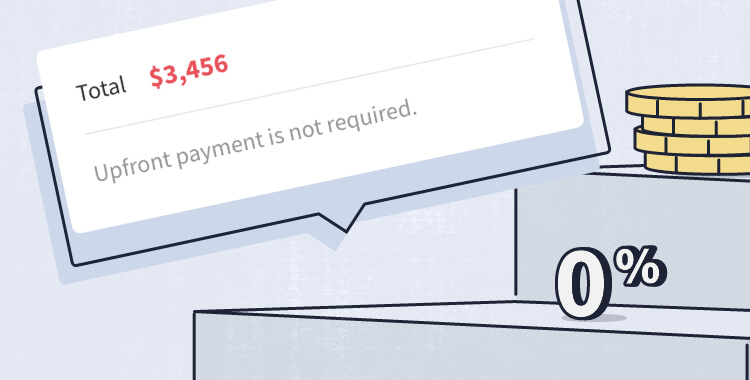How Much Upfront Payment You Should Charge?

Being in business is all about balance, what you offer, balanced to what you receive for it. It is obvious that as you are providing a service, you will expect payment. It should be equally clear to the client that they need to pay. So far, everyone is on the same page.
The question then is quite simply how are these payments going to be structured? In a store, you go in, choose your goods and pay to take them away – done and dusted. In the web design and development field you have options regarding payment schedules and of course the obligatory pros and cons of each..just to help you sleep at night!
Here we will look at the three main options, relying on your own common sense to be able to adapt them and use as you see fit. Our three are the 100% upfront payment, 100% payment on delivery, and the balanced middle ground -we’ll use 50-50, but the essence remains the same for 60/40, 55/45, etc, etc.
And as Einstein said “Life is like riding a bicycle. To keep your balance you must keep moving.” So onwards to find our right balance.
What is an upfront payment?
An upfront payment is simply a transaction where a client or customer pays for the service before it is completed – a kind of deposit. This could be a 100% payment or a partial payment, it could be based on timed payments, or on completion of certain key stages or deliverables, it might be a structured series of payments based on a sliding scale – this very much depends on your own terms and conditions as a business and your negotiations with the client.
If I went to a restaurant and they asked me to pay 50% upfront for my soup and the final 50% after the last spoonful, I’d be confused, to say the least. However, if I booked a table for the weekend for a group at the same restaurant and asked them to prepare a whole lamb, then I’d expect to leave a fair-sized deposit. The point is, in different situations, it isn’t unusual to ask for a form of upfront payment and most clients will expect it in the web industry.
Negotiation is standard, not personal – you play the game and then you shake hands. A well-written set of terms and conditions on your website will establish the boundaries that you can work within and give you a baseline to fall back to. After that, it’s about well-balanced negotiation.
1. The industry-standard – 50% upfront, 50% on completion

Like many industries, Web agencies, design, and development often have an unwritten standard business etiquette for payment that has become the norm…for good reason. Not everyone follows these rules, of course, but this form of mixed payment has a lot going for it.
The idea of a 50% payment upfront and the balance made upon successful completion is quite simply a version of a partial payment scheme, that can be adapted and molded during negotiations either along the lines of percentages or involving a greater breakdown of payments. This gives you flexibility in negotiations especially if you are talking about particularly long and complex projects, but also depending on your relationship and trust in the client….or the relationship you want to embark on with the client.
Pros:
- Trust: An upfront payment establishes an immediate bond between you and the client, you have entered into the contract. This shows you that the client is serious and shows the client that you are confident enough that the result will guarantee the full payment. This trust is the start of the respect that a good business relationship demands in the long term.
- Peace of mind: An upfront payment on the most practical level means that you are getting paid for the work you are doing. You have the money in the bank so you can pay staff, rent, expenses. Cash flow is one of the biggest problems in business today, long projects can take months to complete. Scheduled and upfront payments go a long way to reducing these problems. Additionally, once the client has paid something there is a much greater chance that they will complete all payments.
- Engagement: Once a client has paid for part of the project, they feel more involved, they’ve taken responsibility, and become serious. This engagement is vital for you to get the communication that a successful project requires. When money has changed hands your client wants to know what is happening, what stage are you at – it may seem like a pain but actually this frequent communication is vital to the project and gives you the chance to really cement a relationship for further future collaboration.
- Control: You need to keep control of the project, it really doesn’t matter how big it is, keeping your finger on the pulse is going to help. With the clients, extra engagement, your need to know what’s happening and keep your client informed is greater. This should allow you to keep control of the dreaded scope creep when a project vanishes from all its original features to morph into something completely different.
Cons:
- Restricts clients: By demanding an upfront payment you are risking losing clients who are not prepared for this payment method.
- Trust: Some businesses may question why they are paying for the promise of something. For them they have the fear of giving money for nothing, are you a genuine business, are you good enough to do the job, are you even who you claim to be. This can be especially difficult when you don’t have a physical presence. If I give my builder a 20% deposit for materials, I can see what he’s spent it on, check receipts and I know where he lives. This absolutely does not apply in this field.
- Loyalty: If a client is a loyal customer they like to feel trusted. By demanding an upfront payment it can feel almost as if you are questioning their honesty. This is absolutely worth bearing in mind, you don’t want to offend, but equally, rules are rules and you don’t want to become a pushover.
Within the idea of 50/50 payment, you should be adaptable enough to set in place special circumstance payments. These could be what is often referred to as milestone payments, an upfront deposit, and then additional payment on completion of set stages or goals. You could also consider different percentages based on loyalty, such as 40/60, thus showing your appreciation for the custom without throwing out all your business principles.
2. Or, you should charge a 100% upfront payment?

Many think this is the perfect world, the ideal option, some even offer discounts for total payment upfront. There are clear and obvious benefits to this, you get your money, no risk but what is the client getting from this deal? If you demand complete upfront payment before any work is done, you better have a fine reputation and good negotiating skills. For upfront payments clients will often want something in return, lower price, expedited deadlines, long term obligations, etc. Bear in mind, also that once they’ve paid up they really don’t expect to pay for any extras. You have to judge how much you are willing to give away to get this payment. The other thing is, you need to be pretty confident in your original price quote and communication and control thereafter.
Freelancers often prefer this form of payment, but you are an agency. You don’t want to run the risk of being seen as needing the money, you are more professional than that and surely confident in your product.
Pros:
- Guaranteed payment: You’ve got the money upfront so there are no worries about the client backing out or refusing to pay up. You can set your budget and try to stick to it.
- Negotiating position: You may offer discounts, negotiate terms, etc from a solid position of strength.
- Clients know where they stand: Some clients enjoy the idea that the project is paid for, so they don’t have to worry about future budget issues and won’t get a financial shock later in the year.
Cons:
- Trust and Professional standards: You are going away from the industry standards so you’ll need to have something that makes it worth the client’s risk and be able to live up to their expectations.
- Scaling: If you’ve charged 100% upfront, once the changes start to roll in, and they will, you are left in a difficult position. The client firmly believes this project is paid for, they don’t expect additions or negotiations. When the scope starts to creep, where are you going to draw the line?
- Motivation: The client has paid in full, so what’s the rush? True, your professional pride and honesty should guarantee you try to meet all the deadlines and produce the finest quality work with no short cuts, but there’s no pressure. Another client is hassling you and your team for results, or you desperately want to win a project by offering a rushed deadline – is easy to put this one on the backburner. A slippery slope indeed.
3. What about 0% upfront, payment on satisfaction only.

The complete opposite to the 100% upfront payment, this structure is highly risky but very attractive for clients. At best you and your team are working on a promise of money and although it comes it can damage the essential cash flow required in all businesses. At worst the client simply disappears and you receive nothing at all. Another possible scenario is the renegotiation on completion, you’ve placed yourself in a weak position, the work is done and now you need the money. Some is better than nothing – oh dear, reschedule, promised payments, endless emails, more time spent chasing payments when you should be working on the next projects, not good at all. So, why bother? Well, there are some advantages to this system, as risky as it is.
Pros:
- Attractive to clients: Clients are in a no-lose situation if they don’t like the finished product they don’t pay. Therefore it’s a way of generating a lot of business, especially at the start of your journey and building volume and reputation.
- Highly motivation: You know you have to do a good job to get the payment, how motivating is that?
- Confidence: Nothing shows greater confidence in your abilities and your team than offering this system. You are risking your whole business on the fact that the client will like what you’ve done.
- Scalable: Any additions to the scope can be added on to the price at the end, so you are not beholden to a strict budget. Keep the client informed of cost additions though.
Cons:
- High Risk: Not all clients are honest businesses desperate to pay you what you deserve. Some won’t pay at all, others will want changes before payment, yet more will want to renegotiate payment terms, there can be all sorts of excuses. The client has the power, you’ve tailor-designed and made something that cannot be used elsewhere. If I’ve designed and made a beautiful table for a commissioned order and they don’t want it, the chances are I can sell it to someone else, maybe not at exactly the same price but I’ll get something for it. This is not the case here.
- Shock: If the payment is demanded at the end of the project, and the cost has risen significantly (scope creep, currency exchange rates, etc) this could come as a rather unpleasant surprise. Make sure clients are kept informed of the progress and additions along the way.
- Economic climate: The business climate is changing rapidly, almost on a day-to-day basis. Issues and trends that seemed predictable just a year ago, are now dead in the water. Your long-term project that seemed a sure-fire winner at the time may no longer be the guaranteed success the client thought. Indeed the client themselves may have disappeared alongside their market.
Closing words
Setting your payment terms is setting your business values and controlling what you offer and deliver. The balance between service and payment, what you are prepared to risk to please and win a client, and in some respects what kind of clients you are aiming for. Are you prepared to risk all your hard work for a nonexistent client, can your reputation drag clients to your door willing to pay 100% upfront to guarantee your highly sought after skills, or are you going to play safe and hit the middle ground. There are, of course, elements in between and times when your skills and experience as a manager should see some flexibility but please make some sort of rules that all your managers follow. Have them clear, have them written down, and that way everybody is singing from the same hymn sheet, the terms and conditions are always your fallback position.